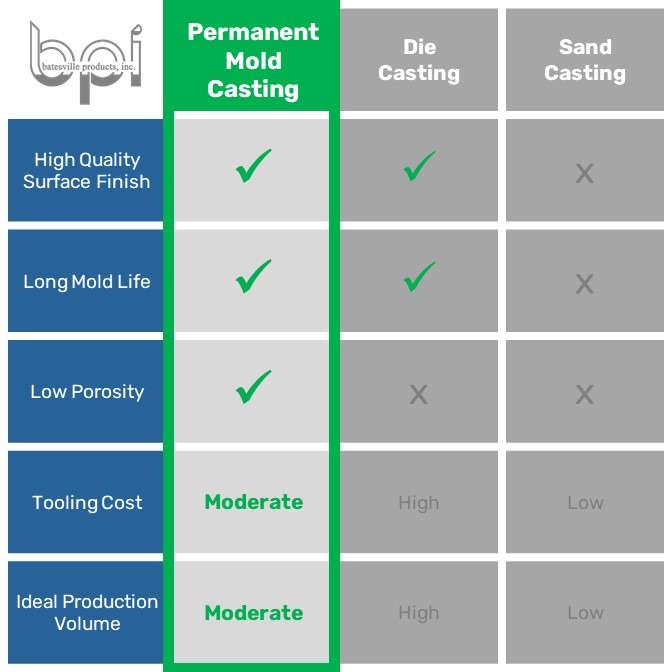Die casting and permanent mold casting are two common casting methods used to produce metal parts with high precision.
While both feature a reusable mold, there are key differences between them.
In die casting, molten metal is pressure-injected into the mold at a high speed.
Because of its high-pressure feeding method, die casting can accommodate thinner walls and less draft. Die castings are known for having one of the best as-cast surface finishes (typically 20-120 RMS).
While the outer as-cast surface finish may be great, die castings can be subject to more internal porosity. This means you may see more defects during machining and polishing.
The aluminum 300 series is common in metal casting. The most common die casting material is aluminum alloy A380.
Die casting is ideal for high volume production because of its high-speed casting and high tooling costs. Therefore, die casting is a very common manufacturing method for automotive and aerospace industries.
Unlike die casting, permanent mold castings are gravity-fed. The metal is poured into a cup, the mold tilts back at a machine-controlled rate, and gravity forces the metal into the mold.
Unlike pressure injections, the tilt pour process results in less metal turbulence, meaning less air bubbles are trapped in the casting. Lower porosity decreases the likelihood of defects in secondary machining or power coating operations.
Permanent mold castings have a required wall thickness of 0.18 inches. This wall thickness ensures proper fill of the mold during the gravity-fed process. More design requirements and tolerances can be found in our 2024 Design Guide.
Permanent mold as-cast surface finish is typically 200-420 RMS. This is higher than die casting, but lower than sand casting. Note that because of lower internal porosity, permanent mold castings are easily polished, and this polishing will not reveal divots or pinholes.
Again, you’ll see the aluminum 300 series used in metal casting. The most common permanent mold casting material is aluminum alloy A356. At Batesville Products, we also cast zinc ZA5 and ZA12.
Permanent mold is ideal for moderate-volume production due to manufacturing speed and tooling cost. Permanent molds can be half the price of die casting molds! Therefore, it’s commonly used to manufacture pressure-tight vessels, utility equipment, medical equipment, and food equipment.

Still not sure which manufacturing method is best for your product? Call us at 812-537-2275 or email us. We’ll point you in the right direction!